Pharmacognosy Report: Analysis of Vaccinium myrtillus Herbal Monograph
VerifiedAdded on 2023/06/08
|12
|3186
|432
Report
AI Summary
This report provides a comprehensive pharmacognosy analysis of Vaccinium myrtillus, commonly known as bilberry. It begins with a detailed botanical description, including its various names and physical characteristics. The report then delves into the relevant constituents of the plant, such as a...
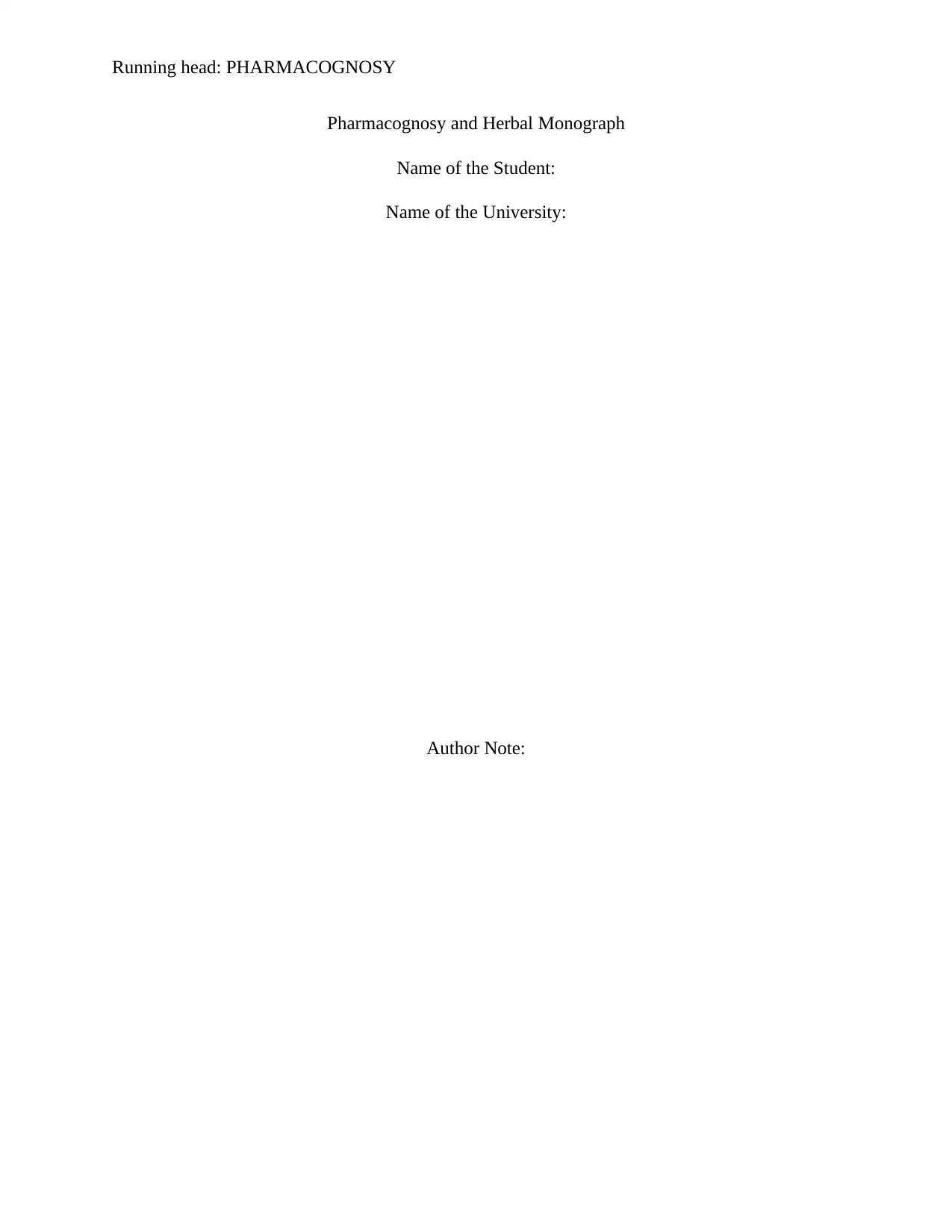
Running head: PHARMACOGNOSY
Pharmacognosy and Herbal Monograph
Name of the Student:
Name of the University:
Author Note:
Pharmacognosy and Herbal Monograph
Name of the Student:
Name of the University:
Author Note:
Paraphrase This Document
Need a fresh take? Get an instant paraphrase of this document with our AI Paraphraser
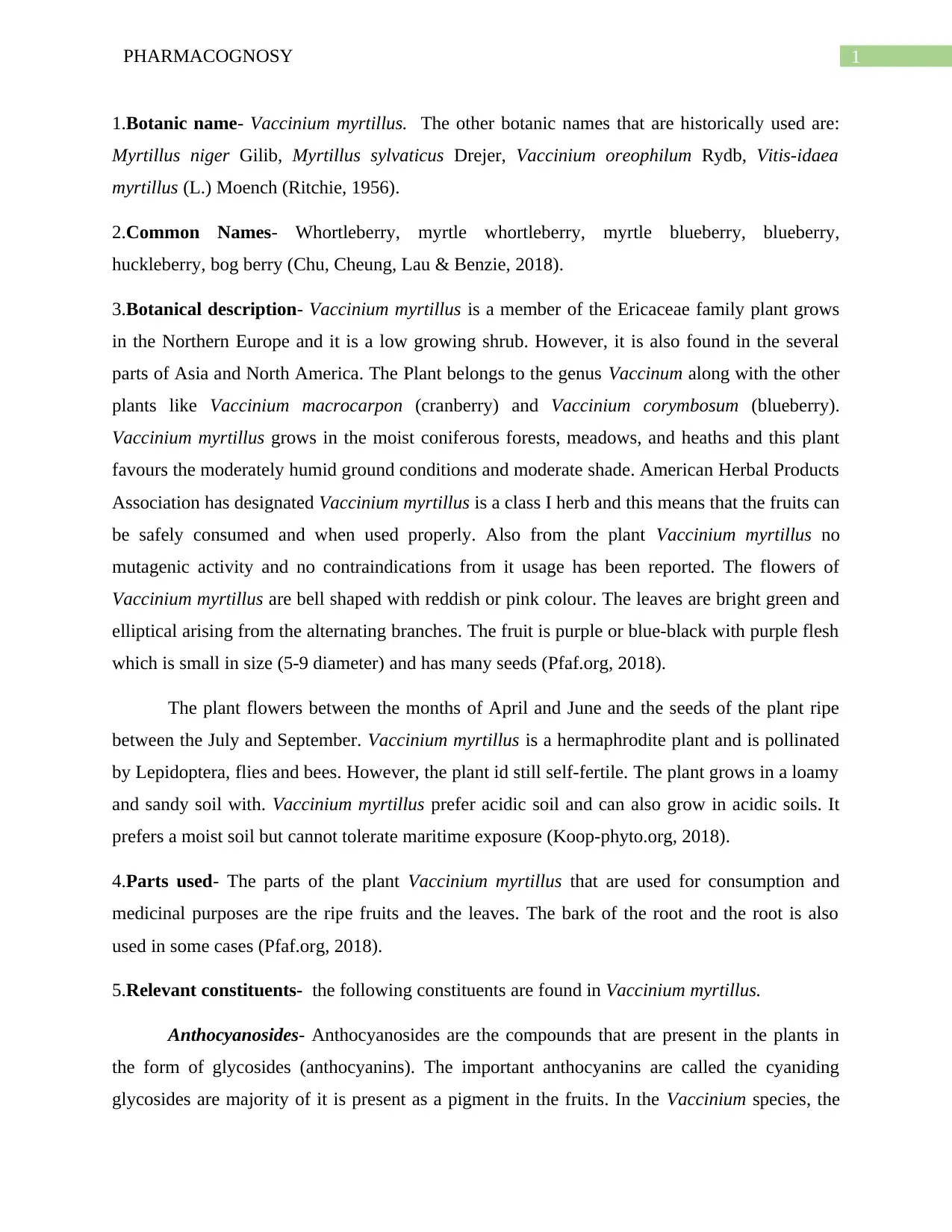
1PHARMACOGNOSY
1.Botanic name- Vaccinium myrtillus. The other botanic names that are historically used are:
Myrtillus niger Gilib, Myrtillus sylvaticus Drejer, Vaccinium oreophilum Rydb, Vitis-idaea
myrtillus (L.) Moench (Ritchie, 1956).
2.Common Names- Whortleberry, myrtle whortleberry, myrtle blueberry, blueberry,
huckleberry, bog berry (Chu, Cheung, Lau & Benzie, 2018).
3.Botanical description- Vaccinium myrtillus is a member of the Ericaceae family plant grows
in the Northern Europe and it is a low growing shrub. However, it is also found in the several
parts of Asia and North America. The Plant belongs to the genus Vaccinum along with the other
plants like Vaccinium macrocarpon (cranberry) and Vaccinium corymbosum (blueberry).
Vaccinium myrtillus grows in the moist coniferous forests, meadows, and heaths and this plant
favours the moderately humid ground conditions and moderate shade. American Herbal Products
Association has designated Vaccinium myrtillus is a class I herb and this means that the fruits can
be safely consumed and when used properly. Also from the plant Vaccinium myrtillus no
mutagenic activity and no contraindications from it usage has been reported. The flowers of
Vaccinium myrtillus are bell shaped with reddish or pink colour. The leaves are bright green and
elliptical arising from the alternating branches. The fruit is purple or blue-black with purple flesh
which is small in size (5-9 diameter) and has many seeds (Pfaf.org, 2018).
The plant flowers between the months of April and June and the seeds of the plant ripe
between the July and September. Vaccinium myrtillus is a hermaphrodite plant and is pollinated
by Lepidoptera, flies and bees. However, the plant id still self-fertile. The plant grows in a loamy
and sandy soil with. Vaccinium myrtillus prefer acidic soil and can also grow in acidic soils. It
prefers a moist soil but cannot tolerate maritime exposure (Koop-phyto.org, 2018).
4.Parts used- The parts of the plant Vaccinium myrtillus that are used for consumption and
medicinal purposes are the ripe fruits and the leaves. The bark of the root and the root is also
used in some cases (Pfaf.org, 2018).
5.Relevant constituents- the following constituents are found in Vaccinium myrtillus.
Anthocyanosides- Anthocyanosides are the compounds that are present in the plants in
the form of glycosides (anthocyanins). The important anthocyanins are called the cyaniding
glycosides are majority of it is present as a pigment in the fruits. In the Vaccinium species, the
1.Botanic name- Vaccinium myrtillus. The other botanic names that are historically used are:
Myrtillus niger Gilib, Myrtillus sylvaticus Drejer, Vaccinium oreophilum Rydb, Vitis-idaea
myrtillus (L.) Moench (Ritchie, 1956).
2.Common Names- Whortleberry, myrtle whortleberry, myrtle blueberry, blueberry,
huckleberry, bog berry (Chu, Cheung, Lau & Benzie, 2018).
3.Botanical description- Vaccinium myrtillus is a member of the Ericaceae family plant grows
in the Northern Europe and it is a low growing shrub. However, it is also found in the several
parts of Asia and North America. The Plant belongs to the genus Vaccinum along with the other
plants like Vaccinium macrocarpon (cranberry) and Vaccinium corymbosum (blueberry).
Vaccinium myrtillus grows in the moist coniferous forests, meadows, and heaths and this plant
favours the moderately humid ground conditions and moderate shade. American Herbal Products
Association has designated Vaccinium myrtillus is a class I herb and this means that the fruits can
be safely consumed and when used properly. Also from the plant Vaccinium myrtillus no
mutagenic activity and no contraindications from it usage has been reported. The flowers of
Vaccinium myrtillus are bell shaped with reddish or pink colour. The leaves are bright green and
elliptical arising from the alternating branches. The fruit is purple or blue-black with purple flesh
which is small in size (5-9 diameter) and has many seeds (Pfaf.org, 2018).
The plant flowers between the months of April and June and the seeds of the plant ripe
between the July and September. Vaccinium myrtillus is a hermaphrodite plant and is pollinated
by Lepidoptera, flies and bees. However, the plant id still self-fertile. The plant grows in a loamy
and sandy soil with. Vaccinium myrtillus prefer acidic soil and can also grow in acidic soils. It
prefers a moist soil but cannot tolerate maritime exposure (Koop-phyto.org, 2018).
4.Parts used- The parts of the plant Vaccinium myrtillus that are used for consumption and
medicinal purposes are the ripe fruits and the leaves. The bark of the root and the root is also
used in some cases (Pfaf.org, 2018).
5.Relevant constituents- the following constituents are found in Vaccinium myrtillus.
Anthocyanosides- Anthocyanosides are the compounds that are present in the plants in
the form of glycosides (anthocyanins). The important anthocyanins are called the cyaniding
glycosides are majority of it is present as a pigment in the fruits. In the Vaccinium species, the
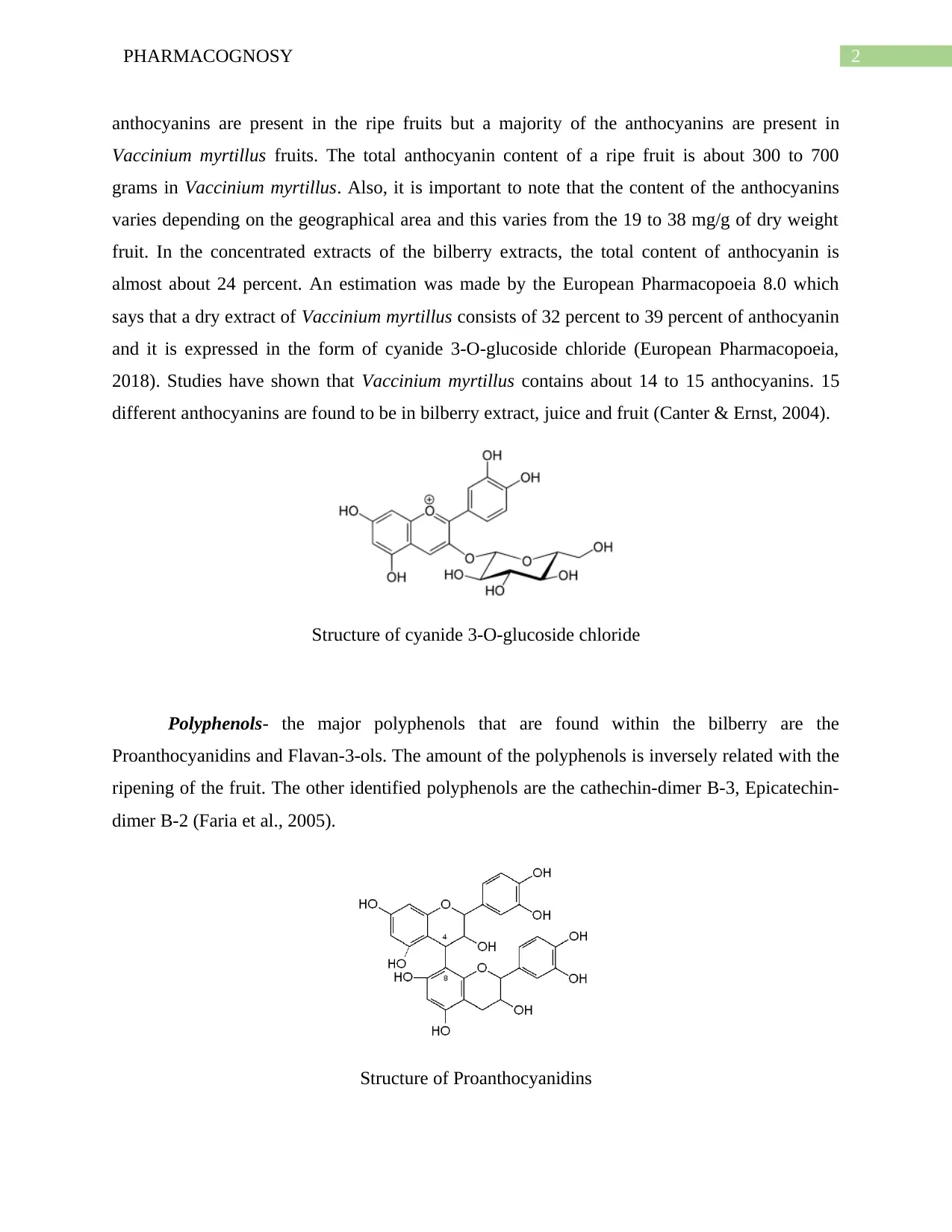
2PHARMACOGNOSY
anthocyanins are present in the ripe fruits but a majority of the anthocyanins are present in
Vaccinium myrtillus fruits. The total anthocyanin content of a ripe fruit is about 300 to 700
grams in Vaccinium myrtillus. Also, it is important to note that the content of the anthocyanins
varies depending on the geographical area and this varies from the 19 to 38 mg/g of dry weight
fruit. In the concentrated extracts of the bilberry extracts, the total content of anthocyanin is
almost about 24 percent. An estimation was made by the European Pharmacopoeia 8.0 which
says that a dry extract of Vaccinium myrtillus consists of 32 percent to 39 percent of anthocyanin
and it is expressed in the form of cyanide 3-O-glucoside chloride (European Pharmacopoeia,
2018). Studies have shown that Vaccinium myrtillus contains about 14 to 15 anthocyanins. 15
different anthocyanins are found to be in bilberry extract, juice and fruit (Canter & Ernst, 2004).
Structure of cyanide 3-O-glucoside chloride
Polyphenols- the major polyphenols that are found within the bilberry are the
Proanthocyanidins and Flavan-3-ols. The amount of the polyphenols is inversely related with the
ripening of the fruit. The other identified polyphenols are the cathechin-dimer B-3, Epicatechin-
dimer B-2 (Faria et al., 2005).
Structure of Proanthocyanidins
anthocyanins are present in the ripe fruits but a majority of the anthocyanins are present in
Vaccinium myrtillus fruits. The total anthocyanin content of a ripe fruit is about 300 to 700
grams in Vaccinium myrtillus. Also, it is important to note that the content of the anthocyanins
varies depending on the geographical area and this varies from the 19 to 38 mg/g of dry weight
fruit. In the concentrated extracts of the bilberry extracts, the total content of anthocyanin is
almost about 24 percent. An estimation was made by the European Pharmacopoeia 8.0 which
says that a dry extract of Vaccinium myrtillus consists of 32 percent to 39 percent of anthocyanin
and it is expressed in the form of cyanide 3-O-glucoside chloride (European Pharmacopoeia,
2018). Studies have shown that Vaccinium myrtillus contains about 14 to 15 anthocyanins. 15
different anthocyanins are found to be in bilberry extract, juice and fruit (Canter & Ernst, 2004).
Structure of cyanide 3-O-glucoside chloride
Polyphenols- the major polyphenols that are found within the bilberry are the
Proanthocyanidins and Flavan-3-ols. The amount of the polyphenols is inversely related with the
ripening of the fruit. The other identified polyphenols are the cathechin-dimer B-3, Epicatechin-
dimer B-2 (Faria et al., 2005).
Structure of Proanthocyanidins
⊘ This is a preview!⊘
Do you want full access?
Subscribe today to unlock all pages.

Trusted by 1+ million students worldwide
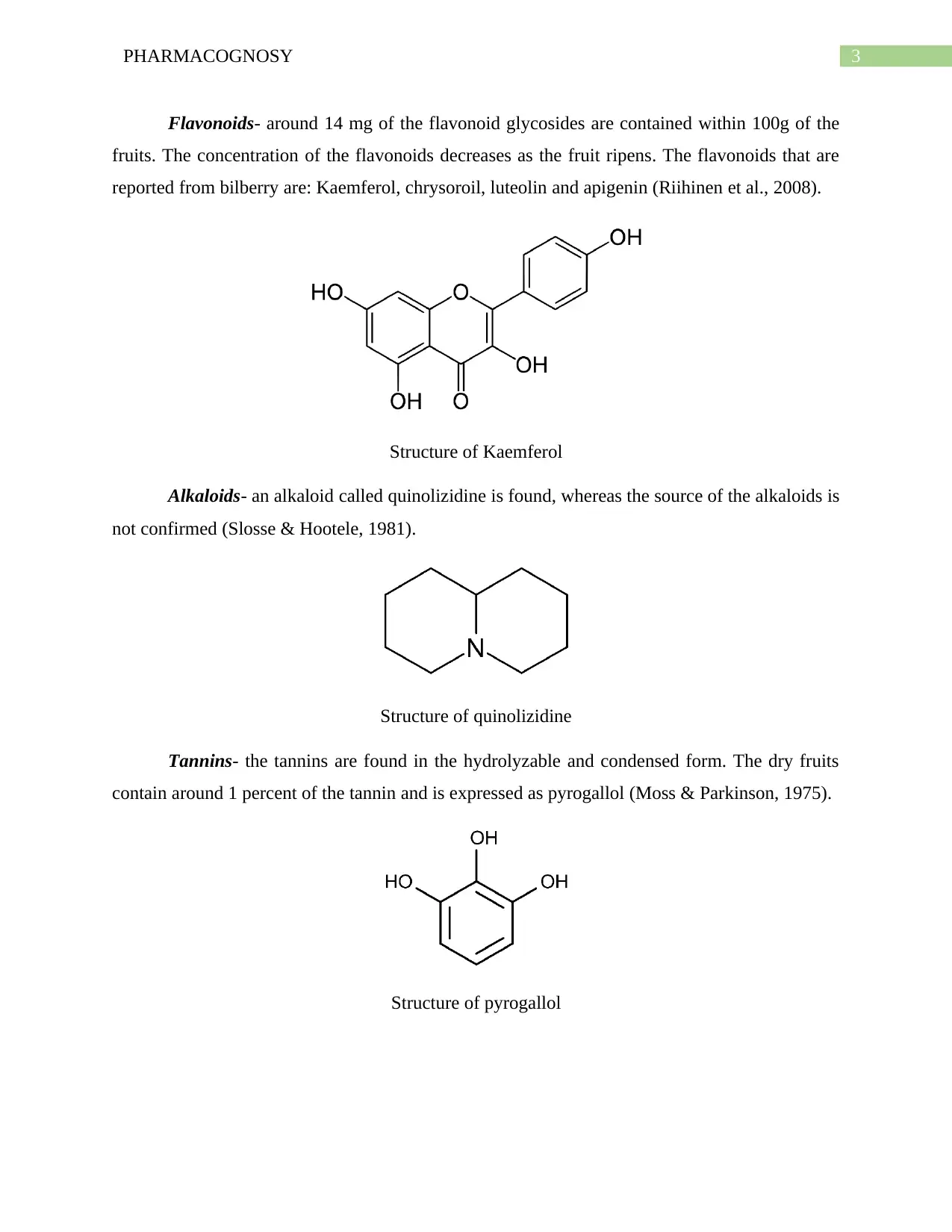
3PHARMACOGNOSY
Flavonoids- around 14 mg of the flavonoid glycosides are contained within 100g of the
fruits. The concentration of the flavonoids decreases as the fruit ripens. The flavonoids that are
reported from bilberry are: Kaemferol, chrysoroil, luteolin and apigenin (Riihinen et al., 2008).
Structure of Kaemferol
Alkaloids- an alkaloid called quinolizidine is found, whereas the source of the alkaloids is
not confirmed (Slosse & Hootele, 1981).
Structure of quinolizidine
Tannins- the tannins are found in the hydrolyzable and condensed form. The dry fruits
contain around 1 percent of the tannin and is expressed as pyrogallol (Moss & Parkinson, 1975).
Structure of pyrogallol
Flavonoids- around 14 mg of the flavonoid glycosides are contained within 100g of the
fruits. The concentration of the flavonoids decreases as the fruit ripens. The flavonoids that are
reported from bilberry are: Kaemferol, chrysoroil, luteolin and apigenin (Riihinen et al., 2008).
Structure of Kaemferol
Alkaloids- an alkaloid called quinolizidine is found, whereas the source of the alkaloids is
not confirmed (Slosse & Hootele, 1981).
Structure of quinolizidine
Tannins- the tannins are found in the hydrolyzable and condensed form. The dry fruits
contain around 1 percent of the tannin and is expressed as pyrogallol (Moss & Parkinson, 1975).
Structure of pyrogallol
Paraphrase This Document
Need a fresh take? Get an instant paraphrase of this document with our AI Paraphraser
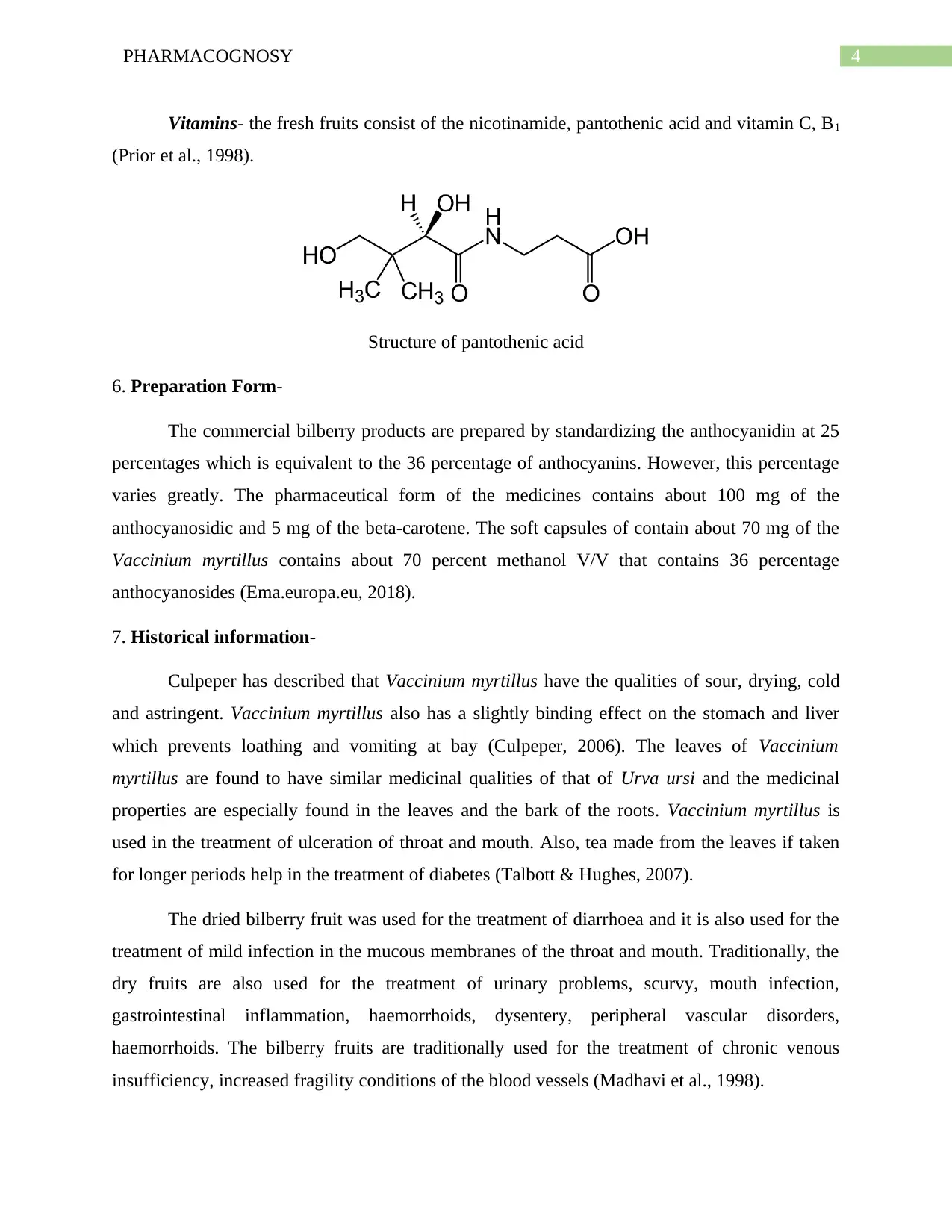
4PHARMACOGNOSY
Vitamins- the fresh fruits consist of the nicotinamide, pantothenic acid and vitamin C, B1
(Prior et al., 1998).
Structure of pantothenic acid
6. Preparation Form-
The commercial bilberry products are prepared by standardizing the anthocyanidin at 25
percentages which is equivalent to the 36 percentage of anthocyanins. However, this percentage
varies greatly. The pharmaceutical form of the medicines contains about 100 mg of the
anthocyanosidic and 5 mg of the beta-carotene. The soft capsules of contain about 70 mg of the
Vaccinium myrtillus contains about 70 percent methanol V/V that contains 36 percentage
anthocyanosides (Ema.europa.eu, 2018).
7. Historical information-
Culpeper has described that Vaccinium myrtillus have the qualities of sour, drying, cold
and astringent. Vaccinium myrtillus also has a slightly binding effect on the stomach and liver
which prevents loathing and vomiting at bay (Culpeper, 2006). The leaves of Vaccinium
myrtillus are found to have similar medicinal qualities of that of Urva ursi and the medicinal
properties are especially found in the leaves and the bark of the roots. Vaccinium myrtillus is
used in the treatment of ulceration of throat and mouth. Also, tea made from the leaves if taken
for longer periods help in the treatment of diabetes (Talbott & Hughes, 2007).
The dried bilberry fruit was used for the treatment of diarrhoea and it is also used for the
treatment of mild infection in the mucous membranes of the throat and mouth. Traditionally, the
dry fruits are also used for the treatment of urinary problems, scurvy, mouth infection,
gastrointestinal inflammation, haemorrhoids, dysentery, peripheral vascular disorders,
haemorrhoids. The bilberry fruits are traditionally used for the treatment of chronic venous
insufficiency, increased fragility conditions of the blood vessels (Madhavi et al., 1998).
Vitamins- the fresh fruits consist of the nicotinamide, pantothenic acid and vitamin C, B1
(Prior et al., 1998).
Structure of pantothenic acid
6. Preparation Form-
The commercial bilberry products are prepared by standardizing the anthocyanidin at 25
percentages which is equivalent to the 36 percentage of anthocyanins. However, this percentage
varies greatly. The pharmaceutical form of the medicines contains about 100 mg of the
anthocyanosidic and 5 mg of the beta-carotene. The soft capsules of contain about 70 mg of the
Vaccinium myrtillus contains about 70 percent methanol V/V that contains 36 percentage
anthocyanosides (Ema.europa.eu, 2018).
7. Historical information-
Culpeper has described that Vaccinium myrtillus have the qualities of sour, drying, cold
and astringent. Vaccinium myrtillus also has a slightly binding effect on the stomach and liver
which prevents loathing and vomiting at bay (Culpeper, 2006). The leaves of Vaccinium
myrtillus are found to have similar medicinal qualities of that of Urva ursi and the medicinal
properties are especially found in the leaves and the bark of the roots. Vaccinium myrtillus is
used in the treatment of ulceration of throat and mouth. Also, tea made from the leaves if taken
for longer periods help in the treatment of diabetes (Talbott & Hughes, 2007).
The dried bilberry fruit was used for the treatment of diarrhoea and it is also used for the
treatment of mild infection in the mucous membranes of the throat and mouth. Traditionally, the
dry fruits are also used for the treatment of urinary problems, scurvy, mouth infection,
gastrointestinal inflammation, haemorrhoids, dysentery, peripheral vascular disorders,
haemorrhoids. The bilberry fruits are traditionally used for the treatment of chronic venous
insufficiency, increased fragility conditions of the blood vessels (Madhavi et al., 1998).
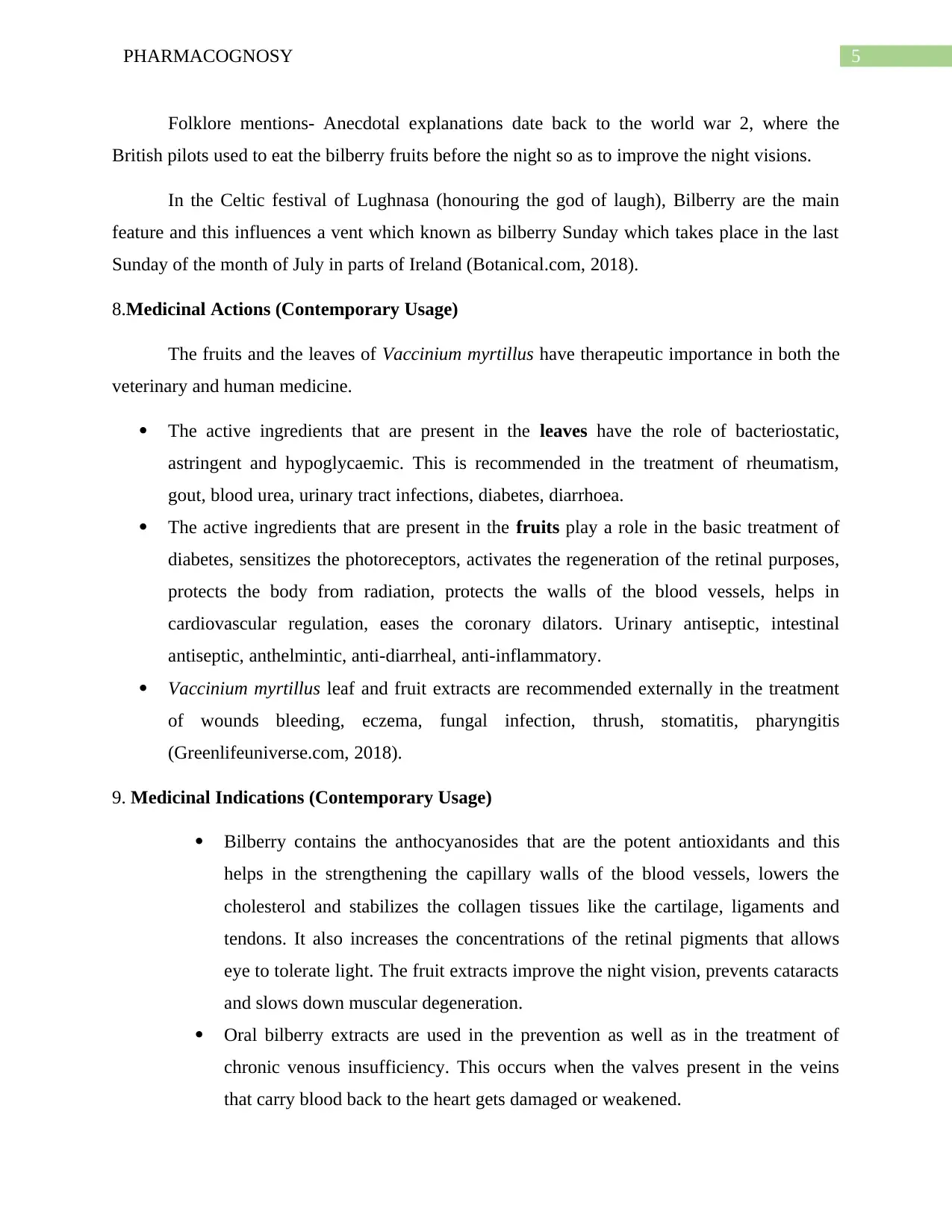
5PHARMACOGNOSY
Folklore mentions- Anecdotal explanations date back to the world war 2, where the
British pilots used to eat the bilberry fruits before the night so as to improve the night visions.
In the Celtic festival of Lughnasa (honouring the god of laugh), Bilberry are the main
feature and this influences a vent which known as bilberry Sunday which takes place in the last
Sunday of the month of July in parts of Ireland (Botanical.com, 2018).
8.Medicinal Actions (Contemporary Usage)
The fruits and the leaves of Vaccinium myrtillus have therapeutic importance in both the
veterinary and human medicine.
The active ingredients that are present in the leaves have the role of bacteriostatic,
astringent and hypoglycaemic. This is recommended in the treatment of rheumatism,
gout, blood urea, urinary tract infections, diabetes, diarrhoea.
The active ingredients that are present in the fruits play a role in the basic treatment of
diabetes, sensitizes the photoreceptors, activates the regeneration of the retinal purposes,
protects the body from radiation, protects the walls of the blood vessels, helps in
cardiovascular regulation, eases the coronary dilators. Urinary antiseptic, intestinal
antiseptic, anthelmintic, anti-diarrheal, anti-inflammatory.
Vaccinium myrtillus leaf and fruit extracts are recommended externally in the treatment
of wounds bleeding, eczema, fungal infection, thrush, stomatitis, pharyngitis
(Greenlifeuniverse.com, 2018).
9. Medicinal Indications (Contemporary Usage)
Bilberry contains the anthocyanosides that are the potent antioxidants and this
helps in the strengthening the capillary walls of the blood vessels, lowers the
cholesterol and stabilizes the collagen tissues like the cartilage, ligaments and
tendons. It also increases the concentrations of the retinal pigments that allows
eye to tolerate light. The fruit extracts improve the night vision, prevents cataracts
and slows down muscular degeneration.
Oral bilberry extracts are used in the prevention as well as in the treatment of
chronic venous insufficiency. This occurs when the valves present in the veins
that carry blood back to the heart gets damaged or weakened.
Folklore mentions- Anecdotal explanations date back to the world war 2, where the
British pilots used to eat the bilberry fruits before the night so as to improve the night visions.
In the Celtic festival of Lughnasa (honouring the god of laugh), Bilberry are the main
feature and this influences a vent which known as bilberry Sunday which takes place in the last
Sunday of the month of July in parts of Ireland (Botanical.com, 2018).
8.Medicinal Actions (Contemporary Usage)
The fruits and the leaves of Vaccinium myrtillus have therapeutic importance in both the
veterinary and human medicine.
The active ingredients that are present in the leaves have the role of bacteriostatic,
astringent and hypoglycaemic. This is recommended in the treatment of rheumatism,
gout, blood urea, urinary tract infections, diabetes, diarrhoea.
The active ingredients that are present in the fruits play a role in the basic treatment of
diabetes, sensitizes the photoreceptors, activates the regeneration of the retinal purposes,
protects the body from radiation, protects the walls of the blood vessels, helps in
cardiovascular regulation, eases the coronary dilators. Urinary antiseptic, intestinal
antiseptic, anthelmintic, anti-diarrheal, anti-inflammatory.
Vaccinium myrtillus leaf and fruit extracts are recommended externally in the treatment
of wounds bleeding, eczema, fungal infection, thrush, stomatitis, pharyngitis
(Greenlifeuniverse.com, 2018).
9. Medicinal Indications (Contemporary Usage)
Bilberry contains the anthocyanosides that are the potent antioxidants and this
helps in the strengthening the capillary walls of the blood vessels, lowers the
cholesterol and stabilizes the collagen tissues like the cartilage, ligaments and
tendons. It also increases the concentrations of the retinal pigments that allows
eye to tolerate light. The fruit extracts improve the night vision, prevents cataracts
and slows down muscular degeneration.
Oral bilberry extracts are used in the prevention as well as in the treatment of
chronic venous insufficiency. This occurs when the valves present in the veins
that carry blood back to the heart gets damaged or weakened.
⊘ This is a preview!⊘
Do you want full access?
Subscribe today to unlock all pages.

Trusted by 1+ million students worldwide
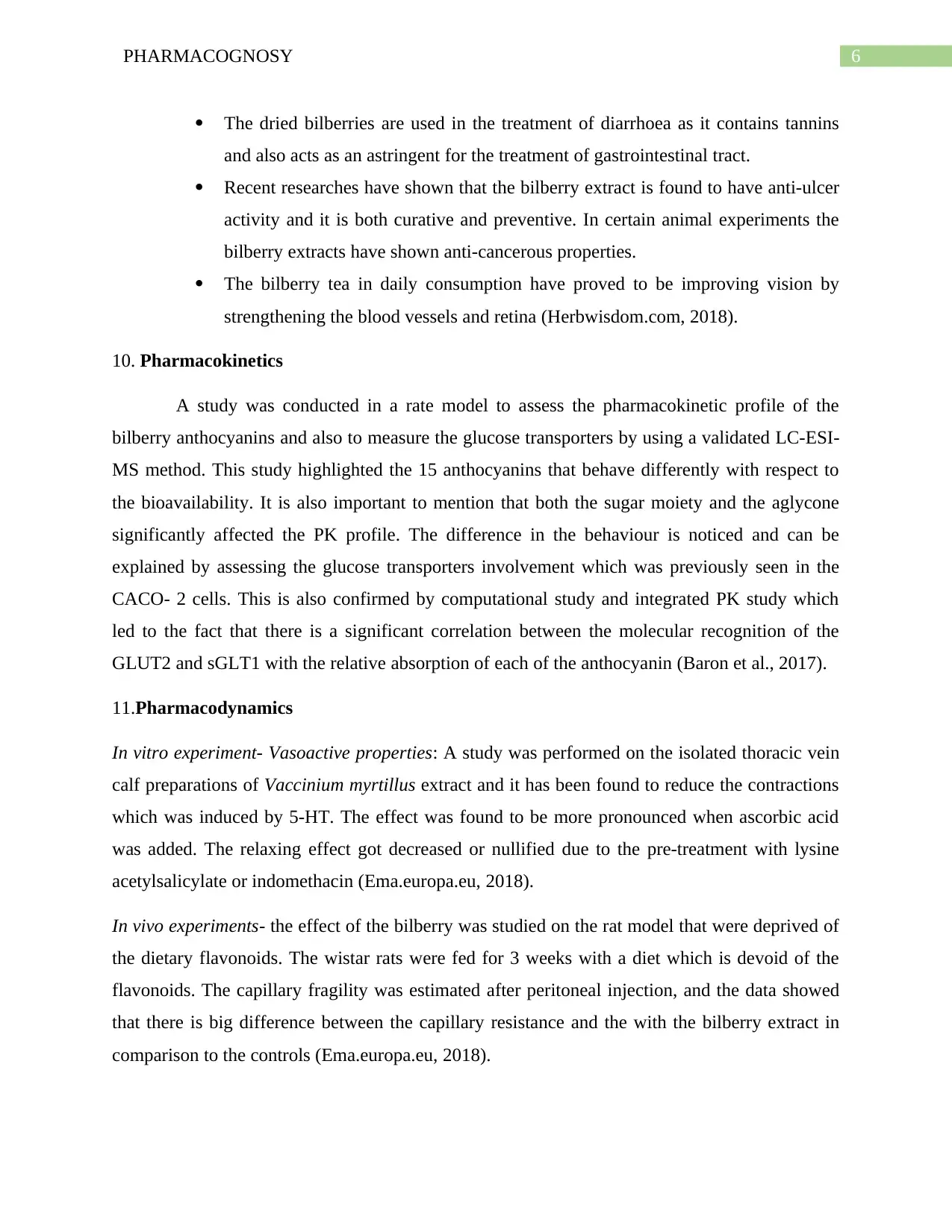
6PHARMACOGNOSY
The dried bilberries are used in the treatment of diarrhoea as it contains tannins
and also acts as an astringent for the treatment of gastrointestinal tract.
Recent researches have shown that the bilberry extract is found to have anti-ulcer
activity and it is both curative and preventive. In certain animal experiments the
bilberry extracts have shown anti-cancerous properties.
The bilberry tea in daily consumption have proved to be improving vision by
strengthening the blood vessels and retina (Herbwisdom.com, 2018).
10. Pharmacokinetics
A study was conducted in a rate model to assess the pharmacokinetic profile of the
bilberry anthocyanins and also to measure the glucose transporters by using a validated LC-ESI-
MS method. This study highlighted the 15 anthocyanins that behave differently with respect to
the bioavailability. It is also important to mention that both the sugar moiety and the aglycone
significantly affected the PK profile. The difference in the behaviour is noticed and can be
explained by assessing the glucose transporters involvement which was previously seen in the
CACO- 2 cells. This is also confirmed by computational study and integrated PK study which
led to the fact that there is a significant correlation between the molecular recognition of the
GLUT2 and sGLT1 with the relative absorption of each of the anthocyanin (Baron et al., 2017).
11.Pharmacodynamics
In vitro experiment- Vasoactive properties: A study was performed on the isolated thoracic vein
calf preparations of Vaccinium myrtillus extract and it has been found to reduce the contractions
which was induced by 5-HT. The effect was found to be more pronounced when ascorbic acid
was added. The relaxing effect got decreased or nullified due to the pre-treatment with lysine
acetylsalicylate or indomethacin (Ema.europa.eu, 2018).
In vivo experiments- the effect of the bilberry was studied on the rat model that were deprived of
the dietary flavonoids. The wistar rats were fed for 3 weeks with a diet which is devoid of the
flavonoids. The capillary fragility was estimated after peritoneal injection, and the data showed
that there is big difference between the capillary resistance and the with the bilberry extract in
comparison to the controls (Ema.europa.eu, 2018).
The dried bilberries are used in the treatment of diarrhoea as it contains tannins
and also acts as an astringent for the treatment of gastrointestinal tract.
Recent researches have shown that the bilberry extract is found to have anti-ulcer
activity and it is both curative and preventive. In certain animal experiments the
bilberry extracts have shown anti-cancerous properties.
The bilberry tea in daily consumption have proved to be improving vision by
strengthening the blood vessels and retina (Herbwisdom.com, 2018).
10. Pharmacokinetics
A study was conducted in a rate model to assess the pharmacokinetic profile of the
bilberry anthocyanins and also to measure the glucose transporters by using a validated LC-ESI-
MS method. This study highlighted the 15 anthocyanins that behave differently with respect to
the bioavailability. It is also important to mention that both the sugar moiety and the aglycone
significantly affected the PK profile. The difference in the behaviour is noticed and can be
explained by assessing the glucose transporters involvement which was previously seen in the
CACO- 2 cells. This is also confirmed by computational study and integrated PK study which
led to the fact that there is a significant correlation between the molecular recognition of the
GLUT2 and sGLT1 with the relative absorption of each of the anthocyanin (Baron et al., 2017).
11.Pharmacodynamics
In vitro experiment- Vasoactive properties: A study was performed on the isolated thoracic vein
calf preparations of Vaccinium myrtillus extract and it has been found to reduce the contractions
which was induced by 5-HT. The effect was found to be more pronounced when ascorbic acid
was added. The relaxing effect got decreased or nullified due to the pre-treatment with lysine
acetylsalicylate or indomethacin (Ema.europa.eu, 2018).
In vivo experiments- the effect of the bilberry was studied on the rat model that were deprived of
the dietary flavonoids. The wistar rats were fed for 3 weeks with a diet which is devoid of the
flavonoids. The capillary fragility was estimated after peritoneal injection, and the data showed
that there is big difference between the capillary resistance and the with the bilberry extract in
comparison to the controls (Ema.europa.eu, 2018).
Paraphrase This Document
Need a fresh take? Get an instant paraphrase of this document with our AI Paraphraser
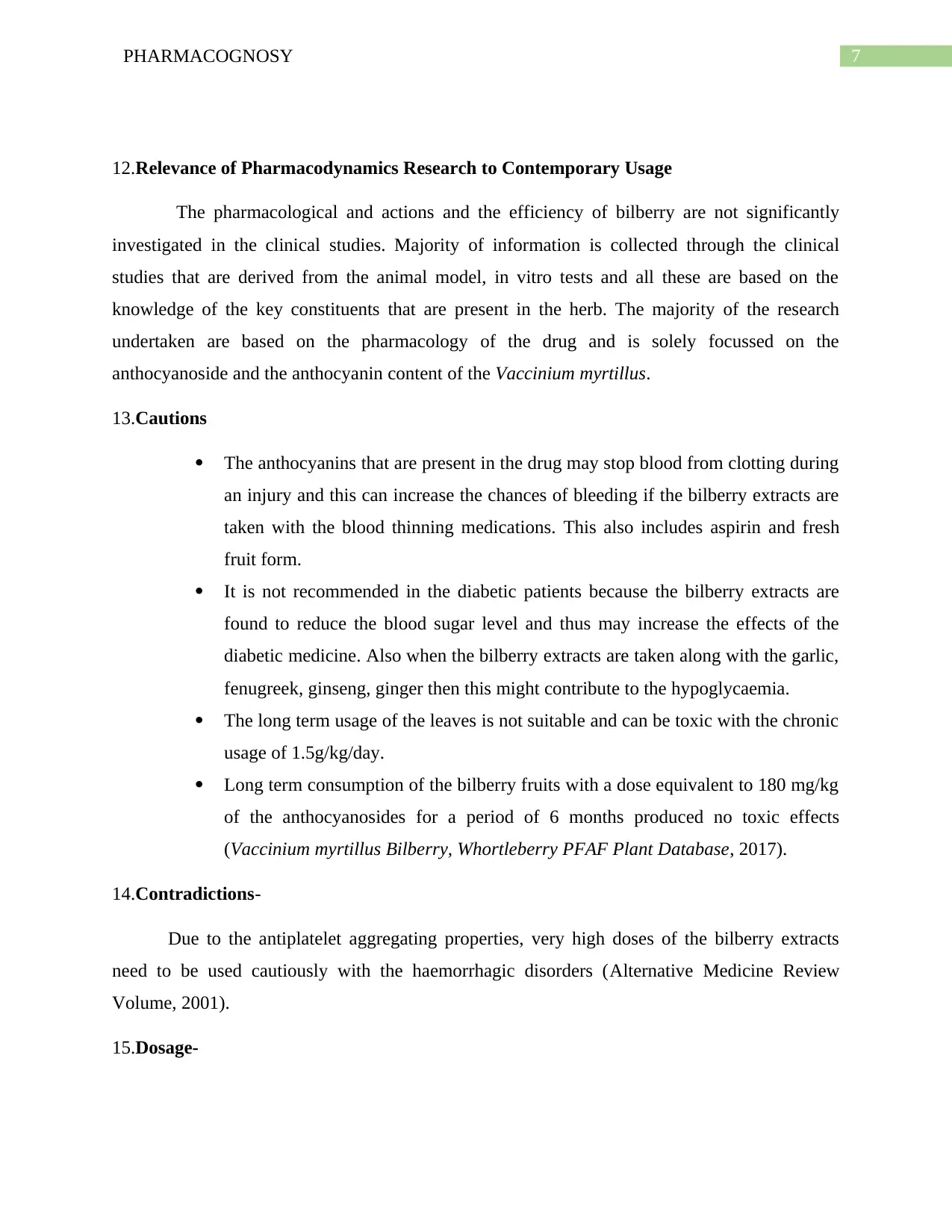
7PHARMACOGNOSY
12.Relevance of Pharmacodynamics Research to Contemporary Usage
The pharmacological and actions and the efficiency of bilberry are not significantly
investigated in the clinical studies. Majority of information is collected through the clinical
studies that are derived from the animal model, in vitro tests and all these are based on the
knowledge of the key constituents that are present in the herb. The majority of the research
undertaken are based on the pharmacology of the drug and is solely focussed on the
anthocyanoside and the anthocyanin content of the Vaccinium myrtillus.
13.Cautions
The anthocyanins that are present in the drug may stop blood from clotting during
an injury and this can increase the chances of bleeding if the bilberry extracts are
taken with the blood thinning medications. This also includes aspirin and fresh
fruit form.
It is not recommended in the diabetic patients because the bilberry extracts are
found to reduce the blood sugar level and thus may increase the effects of the
diabetic medicine. Also when the bilberry extracts are taken along with the garlic,
fenugreek, ginseng, ginger then this might contribute to the hypoglycaemia.
The long term usage of the leaves is not suitable and can be toxic with the chronic
usage of 1.5g/kg/day.
Long term consumption of the bilberry fruits with a dose equivalent to 180 mg/kg
of the anthocyanosides for a period of 6 months produced no toxic effects
(Vaccinium myrtillus Bilberry, Whortleberry PFAF Plant Database, 2017).
14.Contradictions-
Due to the antiplatelet aggregating properties, very high doses of the bilberry extracts
need to be used cautiously with the haemorrhagic disorders (Alternative Medicine Review
Volume, 2001).
15.Dosage-
12.Relevance of Pharmacodynamics Research to Contemporary Usage
The pharmacological and actions and the efficiency of bilberry are not significantly
investigated in the clinical studies. Majority of information is collected through the clinical
studies that are derived from the animal model, in vitro tests and all these are based on the
knowledge of the key constituents that are present in the herb. The majority of the research
undertaken are based on the pharmacology of the drug and is solely focussed on the
anthocyanoside and the anthocyanin content of the Vaccinium myrtillus.
13.Cautions
The anthocyanins that are present in the drug may stop blood from clotting during
an injury and this can increase the chances of bleeding if the bilberry extracts are
taken with the blood thinning medications. This also includes aspirin and fresh
fruit form.
It is not recommended in the diabetic patients because the bilberry extracts are
found to reduce the blood sugar level and thus may increase the effects of the
diabetic medicine. Also when the bilberry extracts are taken along with the garlic,
fenugreek, ginseng, ginger then this might contribute to the hypoglycaemia.
The long term usage of the leaves is not suitable and can be toxic with the chronic
usage of 1.5g/kg/day.
Long term consumption of the bilberry fruits with a dose equivalent to 180 mg/kg
of the anthocyanosides for a period of 6 months produced no toxic effects
(Vaccinium myrtillus Bilberry, Whortleberry PFAF Plant Database, 2017).
14.Contradictions-
Due to the antiplatelet aggregating properties, very high doses of the bilberry extracts
need to be used cautiously with the haemorrhagic disorders (Alternative Medicine Review
Volume, 2001).
15.Dosage-
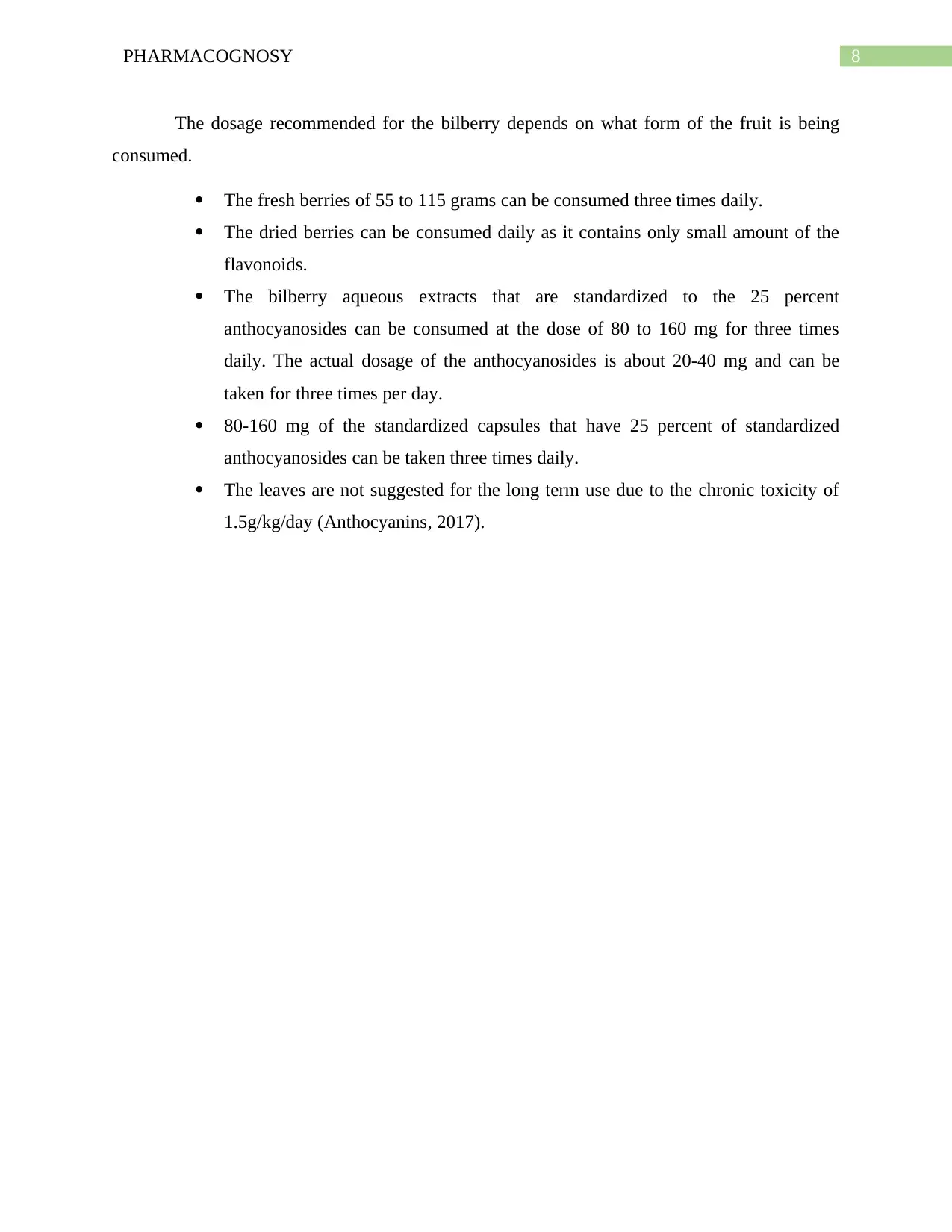
8PHARMACOGNOSY
The dosage recommended for the bilberry depends on what form of the fruit is being
consumed.
The fresh berries of 55 to 115 grams can be consumed three times daily.
The dried berries can be consumed daily as it contains only small amount of the
flavonoids.
The bilberry aqueous extracts that are standardized to the 25 percent
anthocyanosides can be consumed at the dose of 80 to 160 mg for three times
daily. The actual dosage of the anthocyanosides is about 20-40 mg and can be
taken for three times per day.
80-160 mg of the standardized capsules that have 25 percent of standardized
anthocyanosides can be taken three times daily.
The leaves are not suggested for the long term use due to the chronic toxicity of
1.5g/kg/day (Anthocyanins, 2017).
The dosage recommended for the bilberry depends on what form of the fruit is being
consumed.
The fresh berries of 55 to 115 grams can be consumed three times daily.
The dried berries can be consumed daily as it contains only small amount of the
flavonoids.
The bilberry aqueous extracts that are standardized to the 25 percent
anthocyanosides can be consumed at the dose of 80 to 160 mg for three times
daily. The actual dosage of the anthocyanosides is about 20-40 mg and can be
taken for three times per day.
80-160 mg of the standardized capsules that have 25 percent of standardized
anthocyanosides can be taken three times daily.
The leaves are not suggested for the long term use due to the chronic toxicity of
1.5g/kg/day (Anthocyanins, 2017).
⊘ This is a preview!⊘
Do you want full access?
Subscribe today to unlock all pages.

Trusted by 1+ million students worldwide
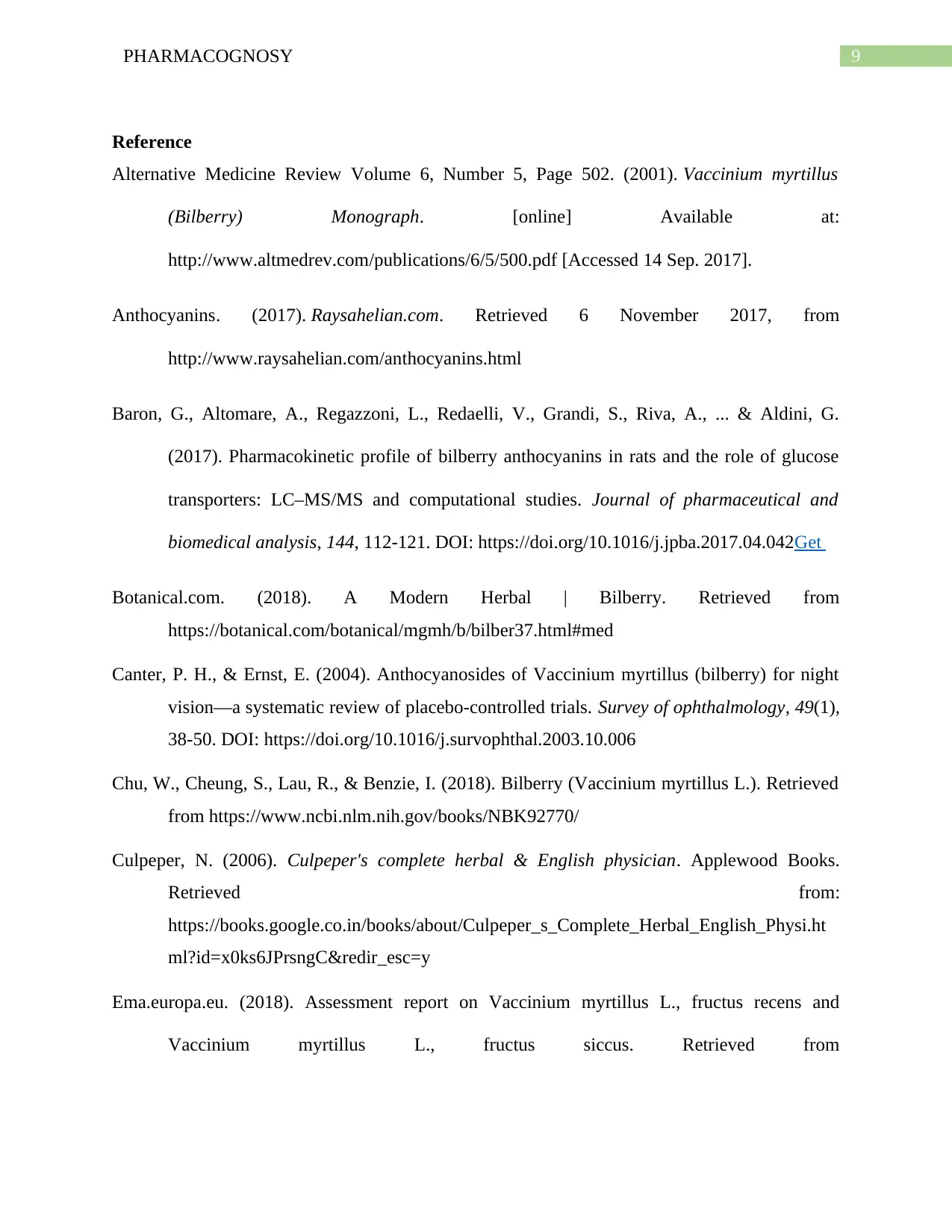
9PHARMACOGNOSY
Reference
Alternative Medicine Review Volume 6, Number 5, Page 502. (2001). Vaccinium myrtillus
(Bilberry) Monograph. [online] Available at:
http://www.altmedrev.com/publications/6/5/500.pdf [Accessed 14 Sep. 2017].
Anthocyanins. (2017). Raysahelian.com. Retrieved 6 November 2017, from
http://www.raysahelian.com/anthocyanins.html
Baron, G., Altomare, A., Regazzoni, L., Redaelli, V., Grandi, S., Riva, A., ... & Aldini, G.
(2017). Pharmacokinetic profile of bilberry anthocyanins in rats and the role of glucose
transporters: LC–MS/MS and computational studies. Journal of pharmaceutical and
biomedical analysis, 144, 112-121. DOI: https://doi.org/10.1016/j.jpba.2017.04.042Get
Botanical.com. (2018). A Modern Herbal | Bilberry. Retrieved from
https://botanical.com/botanical/mgmh/b/bilber37.html#med
Canter, P. H., & Ernst, E. (2004). Anthocyanosides of Vaccinium myrtillus (bilberry) for night
vision—a systematic review of placebo-controlled trials. Survey of ophthalmology, 49(1),
38-50. DOI: https://doi.org/10.1016/j.survophthal.2003.10.006
Chu, W., Cheung, S., Lau, R., & Benzie, I. (2018). Bilberry (Vaccinium myrtillus L.). Retrieved
from https://www.ncbi.nlm.nih.gov/books/NBK92770/
Culpeper, N. (2006). Culpeper's complete herbal & English physician. Applewood Books.
Retrieved from:
https://books.google.co.in/books/about/Culpeper_s_Complete_Herbal_English_Physi.ht
ml?id=x0ks6JPrsngC&redir_esc=y
Ema.europa.eu. (2018). Assessment report on Vaccinium myrtillus L., fructus recens and
Vaccinium myrtillus L., fructus siccus. Retrieved from
Reference
Alternative Medicine Review Volume 6, Number 5, Page 502. (2001). Vaccinium myrtillus
(Bilberry) Monograph. [online] Available at:
http://www.altmedrev.com/publications/6/5/500.pdf [Accessed 14 Sep. 2017].
Anthocyanins. (2017). Raysahelian.com. Retrieved 6 November 2017, from
http://www.raysahelian.com/anthocyanins.html
Baron, G., Altomare, A., Regazzoni, L., Redaelli, V., Grandi, S., Riva, A., ... & Aldini, G.
(2017). Pharmacokinetic profile of bilberry anthocyanins in rats and the role of glucose
transporters: LC–MS/MS and computational studies. Journal of pharmaceutical and
biomedical analysis, 144, 112-121. DOI: https://doi.org/10.1016/j.jpba.2017.04.042Get
Botanical.com. (2018). A Modern Herbal | Bilberry. Retrieved from
https://botanical.com/botanical/mgmh/b/bilber37.html#med
Canter, P. H., & Ernst, E. (2004). Anthocyanosides of Vaccinium myrtillus (bilberry) for night
vision—a systematic review of placebo-controlled trials. Survey of ophthalmology, 49(1),
38-50. DOI: https://doi.org/10.1016/j.survophthal.2003.10.006
Chu, W., Cheung, S., Lau, R., & Benzie, I. (2018). Bilberry (Vaccinium myrtillus L.). Retrieved
from https://www.ncbi.nlm.nih.gov/books/NBK92770/
Culpeper, N. (2006). Culpeper's complete herbal & English physician. Applewood Books.
Retrieved from:
https://books.google.co.in/books/about/Culpeper_s_Complete_Herbal_English_Physi.ht
ml?id=x0ks6JPrsngC&redir_esc=y
Ema.europa.eu. (2018). Assessment report on Vaccinium myrtillus L., fructus recens and
Vaccinium myrtillus L., fructus siccus. Retrieved from
Paraphrase This Document
Need a fresh take? Get an instant paraphrase of this document with our AI Paraphraser
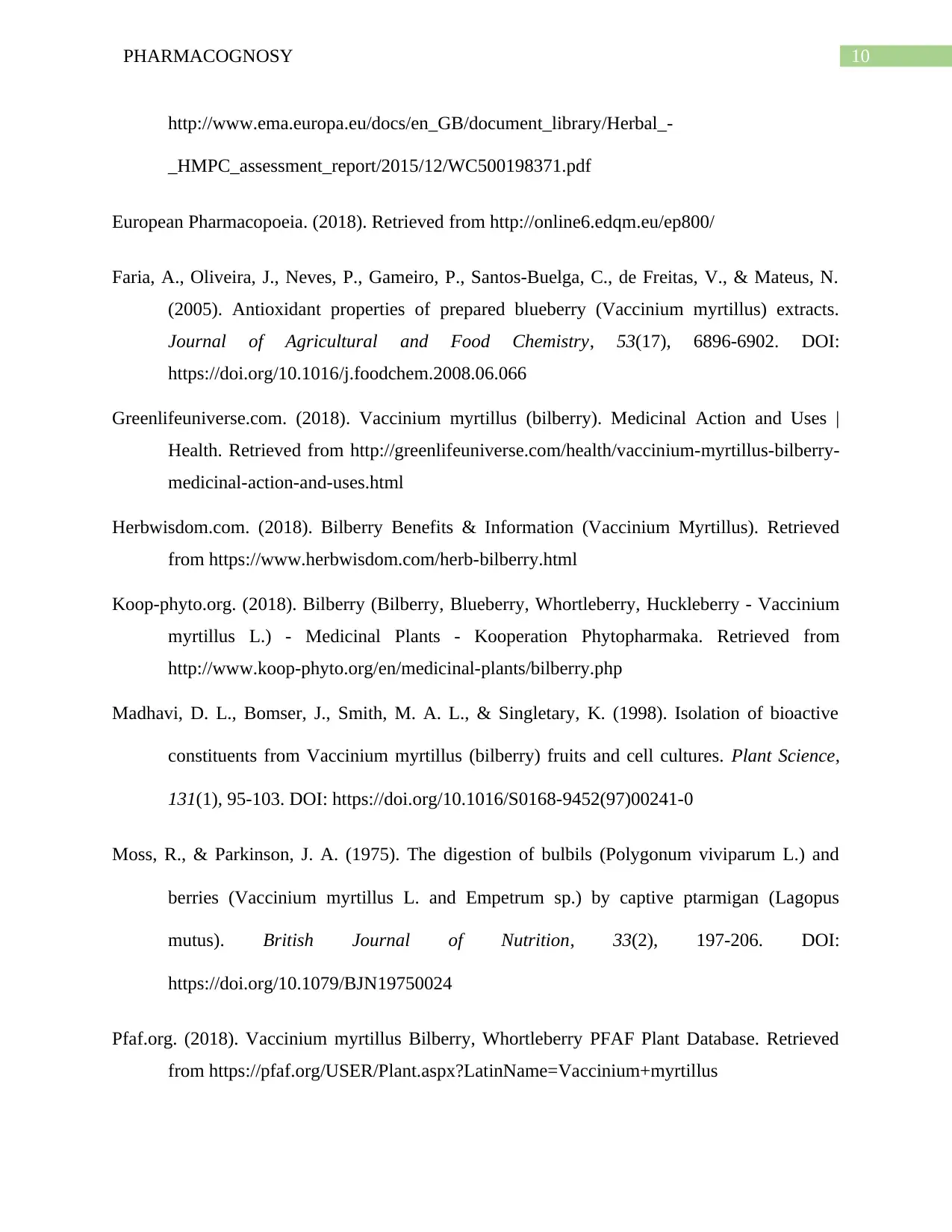
10PHARMACOGNOSY
http://www.ema.europa.eu/docs/en_GB/document_library/Herbal_-
_HMPC_assessment_report/2015/12/WC500198371.pdf
European Pharmacopoeia. (2018). Retrieved from http://online6.edqm.eu/ep800/
Faria, A., Oliveira, J., Neves, P., Gameiro, P., Santos-Buelga, C., de Freitas, V., & Mateus, N.
(2005). Antioxidant properties of prepared blueberry (Vaccinium myrtillus) extracts.
Journal of Agricultural and Food Chemistry, 53(17), 6896-6902. DOI:
https://doi.org/10.1016/j.foodchem.2008.06.066
Greenlifeuniverse.com. (2018). Vaccinium myrtillus (bilberry). Medicinal Action and Uses |
Health. Retrieved from http://greenlifeuniverse.com/health/vaccinium-myrtillus-bilberry-
medicinal-action-and-uses.html
Herbwisdom.com. (2018). Bilberry Benefits & Information (Vaccinium Myrtillus). Retrieved
from https://www.herbwisdom.com/herb-bilberry.html
Koop-phyto.org. (2018). Bilberry (Bilberry, Blueberry, Whortleberry, Huckleberry - Vaccinium
myrtillus L.) - Medicinal Plants - Kooperation Phytopharmaka. Retrieved from
http://www.koop-phyto.org/en/medicinal-plants/bilberry.php
Madhavi, D. L., Bomser, J., Smith, M. A. L., & Singletary, K. (1998). Isolation of bioactive
constituents from Vaccinium myrtillus (bilberry) fruits and cell cultures. Plant Science,
131(1), 95-103. DOI: https://doi.org/10.1016/S0168-9452(97)00241-0
Moss, R., & Parkinson, J. A. (1975). The digestion of bulbils (Polygonum viviparum L.) and
berries (Vaccinium myrtillus L. and Empetrum sp.) by captive ptarmigan (Lagopus
mutus). British Journal of Nutrition, 33(2), 197-206. DOI:
https://doi.org/10.1079/BJN19750024
Pfaf.org. (2018). Vaccinium myrtillus Bilberry, Whortleberry PFAF Plant Database. Retrieved
from https://pfaf.org/USER/Plant.aspx?LatinName=Vaccinium+myrtillus
http://www.ema.europa.eu/docs/en_GB/document_library/Herbal_-
_HMPC_assessment_report/2015/12/WC500198371.pdf
European Pharmacopoeia. (2018). Retrieved from http://online6.edqm.eu/ep800/
Faria, A., Oliveira, J., Neves, P., Gameiro, P., Santos-Buelga, C., de Freitas, V., & Mateus, N.
(2005). Antioxidant properties of prepared blueberry (Vaccinium myrtillus) extracts.
Journal of Agricultural and Food Chemistry, 53(17), 6896-6902. DOI:
https://doi.org/10.1016/j.foodchem.2008.06.066
Greenlifeuniverse.com. (2018). Vaccinium myrtillus (bilberry). Medicinal Action and Uses |
Health. Retrieved from http://greenlifeuniverse.com/health/vaccinium-myrtillus-bilberry-
medicinal-action-and-uses.html
Herbwisdom.com. (2018). Bilberry Benefits & Information (Vaccinium Myrtillus). Retrieved
from https://www.herbwisdom.com/herb-bilberry.html
Koop-phyto.org. (2018). Bilberry (Bilberry, Blueberry, Whortleberry, Huckleberry - Vaccinium
myrtillus L.) - Medicinal Plants - Kooperation Phytopharmaka. Retrieved from
http://www.koop-phyto.org/en/medicinal-plants/bilberry.php
Madhavi, D. L., Bomser, J., Smith, M. A. L., & Singletary, K. (1998). Isolation of bioactive
constituents from Vaccinium myrtillus (bilberry) fruits and cell cultures. Plant Science,
131(1), 95-103. DOI: https://doi.org/10.1016/S0168-9452(97)00241-0
Moss, R., & Parkinson, J. A. (1975). The digestion of bulbils (Polygonum viviparum L.) and
berries (Vaccinium myrtillus L. and Empetrum sp.) by captive ptarmigan (Lagopus
mutus). British Journal of Nutrition, 33(2), 197-206. DOI:
https://doi.org/10.1079/BJN19750024
Pfaf.org. (2018). Vaccinium myrtillus Bilberry, Whortleberry PFAF Plant Database. Retrieved
from https://pfaf.org/USER/Plant.aspx?LatinName=Vaccinium+myrtillus
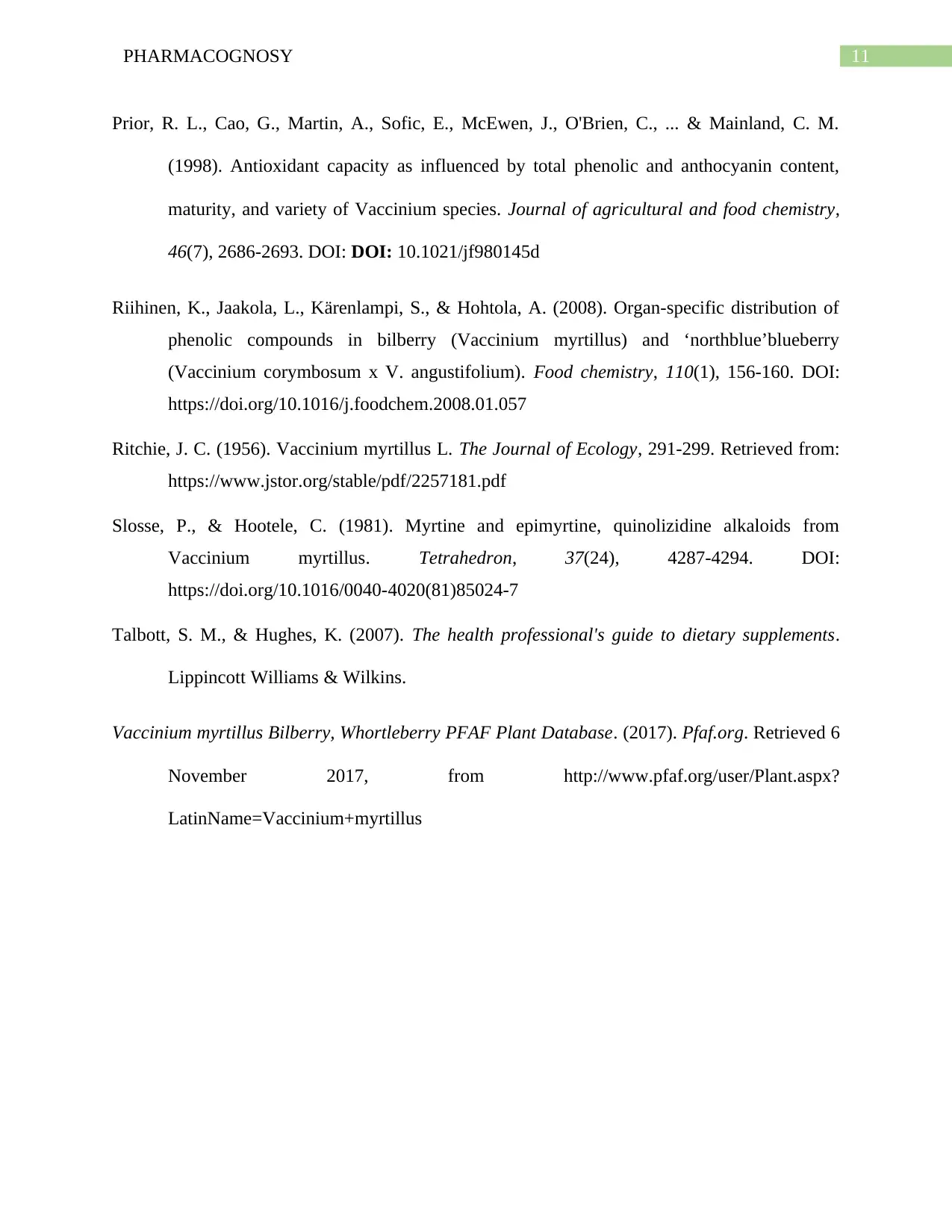
11PHARMACOGNOSY
Prior, R. L., Cao, G., Martin, A., Sofic, E., McEwen, J., O'Brien, C., ... & Mainland, C. M.
(1998). Antioxidant capacity as influenced by total phenolic and anthocyanin content,
maturity, and variety of Vaccinium species. Journal of agricultural and food chemistry,
46(7), 2686-2693. DOI: DOI: 10.1021/jf980145d
Riihinen, K., Jaakola, L., Kärenlampi, S., & Hohtola, A. (2008). Organ-specific distribution of
phenolic compounds in bilberry (Vaccinium myrtillus) and ‘northblue’blueberry
(Vaccinium corymbosum x V. angustifolium). Food chemistry, 110(1), 156-160. DOI:
https://doi.org/10.1016/j.foodchem.2008.01.057
Ritchie, J. C. (1956). Vaccinium myrtillus L. The Journal of Ecology, 291-299. Retrieved from:
https://www.jstor.org/stable/pdf/2257181.pdf
Slosse, P., & Hootele, C. (1981). Myrtine and epimyrtine, quinolizidine alkaloids from
Vaccinium myrtillus. Tetrahedron, 37(24), 4287-4294. DOI:
https://doi.org/10.1016/0040-4020(81)85024-7
Talbott, S. M., & Hughes, K. (2007). The health professional's guide to dietary supplements.
Lippincott Williams & Wilkins.
Vaccinium myrtillus Bilberry, Whortleberry PFAF Plant Database. (2017). Pfaf.org. Retrieved 6
November 2017, from http://www.pfaf.org/user/Plant.aspx?
LatinName=Vaccinium+myrtillus
Prior, R. L., Cao, G., Martin, A., Sofic, E., McEwen, J., O'Brien, C., ... & Mainland, C. M.
(1998). Antioxidant capacity as influenced by total phenolic and anthocyanin content,
maturity, and variety of Vaccinium species. Journal of agricultural and food chemistry,
46(7), 2686-2693. DOI: DOI: 10.1021/jf980145d
Riihinen, K., Jaakola, L., Kärenlampi, S., & Hohtola, A. (2008). Organ-specific distribution of
phenolic compounds in bilberry (Vaccinium myrtillus) and ‘northblue’blueberry
(Vaccinium corymbosum x V. angustifolium). Food chemistry, 110(1), 156-160. DOI:
https://doi.org/10.1016/j.foodchem.2008.01.057
Ritchie, J. C. (1956). Vaccinium myrtillus L. The Journal of Ecology, 291-299. Retrieved from:
https://www.jstor.org/stable/pdf/2257181.pdf
Slosse, P., & Hootele, C. (1981). Myrtine and epimyrtine, quinolizidine alkaloids from
Vaccinium myrtillus. Tetrahedron, 37(24), 4287-4294. DOI:
https://doi.org/10.1016/0040-4020(81)85024-7
Talbott, S. M., & Hughes, K. (2007). The health professional's guide to dietary supplements.
Lippincott Williams & Wilkins.
Vaccinium myrtillus Bilberry, Whortleberry PFAF Plant Database. (2017). Pfaf.org. Retrieved 6
November 2017, from http://www.pfaf.org/user/Plant.aspx?
LatinName=Vaccinium+myrtillus
⊘ This is a preview!⊘
Do you want full access?
Subscribe today to unlock all pages.

Trusted by 1+ million students worldwide
1 out of 12
Your All-in-One AI-Powered Toolkit for Academic Success.
+13062052269
info@desklib.com
Available 24*7 on WhatsApp / Email
![[object Object]](/_next/static/media/star-bottom.7253800d.svg)
Unlock your academic potential
© 2024 | Zucol Services PVT LTD | All rights reserved.